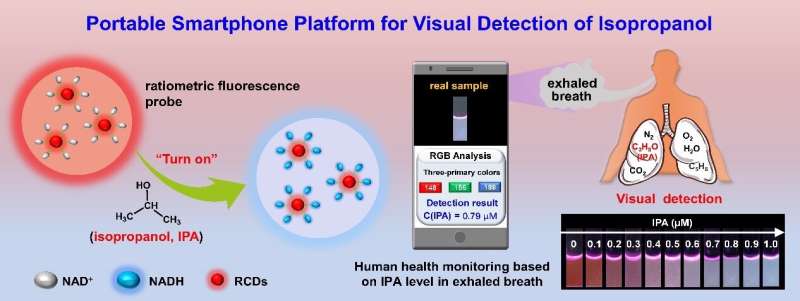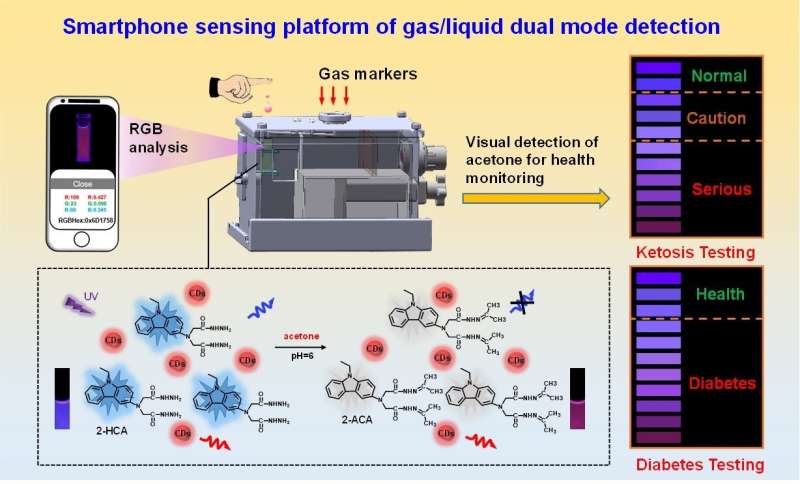
A latest platform, developed by Prof. Jiang Changlong’s research team from the Hefei Institutes of Physical Science of the Chinese Academy of Sciences, has realized visual detection analysis for lung cancer and ketosis/diabetes via different testing probes.
The researchers designed and prepared two high-efficiency organic ratio fluorescent nanoprobes, and realized the detection of biomarkers in exhaled breath by combining with the color recognizer of the smartphone.
Although many diseases have no obvious symptoms when diagnosed early, corresponding signals, such as sweat, urine, tears, blood, and exhaled gas, are usually sent out as early warnings.
Here, a portable smart phone platform based on a single-particle dual-emission ratio fluorescent probe the researchers designed realized the visual detection of isopropanol in exhaled breath to achieve the purpose of early lung cancer risk warning. Another fluorescent sensor platform they designed can effectively capture acetone in blood and exhaled breath and give warning of ketosis/diabetes.
The researchers developed corresponding ratio fluorescent probes to identify acetone and isopropanol, and used 3D printing technology and a smartphone APP (color recognizer) to complete the visualization, on-site and semi-quantitative detection of biomarkers.

With the ratio fluorescence strategy, two different colors of fluorescence probe are mixed at an appropriate ratio. When the biomarker is present, one type of fluorescence is quenched while the internal standard fluorescence remains unchanged, so that it can present a clear color under an ultraviolet lamp irradiation. Using a smart phone to recognize the color RGB value of the fluorescent probe solution can realize the visualization, real-time and semi-quantitative detection of the target analyte.
As for the ratio probe, it is prepared by carbon dots with low toxicity, high luminous efficiency and organic fluorescent materials with a wide luminous color range, easy modification of the structure, and good tunability. It has a lower detection limit for biomarkers, which can realize early warning of human health. Combined with the fluorescence sensing platform prepared by the smart phone, on-site, fast, semi-quantitative, and visual detection can be performed.
The designed methods provide a convenient way to hopefully expand the application of potential volatile biomarker studies in initial monitoring and clinical diagnosis.
Related results have been published in Analytical Chemistry and Microchimica Acta.
The advantage of 2D metal-organic framework nanosheets in sensing applications
Fan Yang et al, Portable Smartphone Platform Based on a Single Dual-Emissive Ratiometric Fluorescent Probe for Visual Detection of Isopropanol in Exhaled Breath, Analytical Chemistry (2021). DOI: 10.1021/acs.analchem.1c03280
Fan Yang et al, 3D-printed smartphone-based device for fluorimetric diagnosis of ketosis by acetone-responsive dye marker and red emissive carbon dots, Microchimica Acta (2021). DOI: 10.1007/s00604-021-04965-0
Chinese Academy of Sciences
Citation:
Smartphone sensing platform provides early warning for lung cancer and ketosis/diabetes (2021, October 27)
retrieved 27 October 2021
from https://phys.org/news/2021-10-smartphone-platform-early-lung-cancer.html
This document is subject to copyright. Apart from any fair dealing for the purpose of private study or research, no
part may be reproduced without the written permission. The content is provided for information purposes only.








